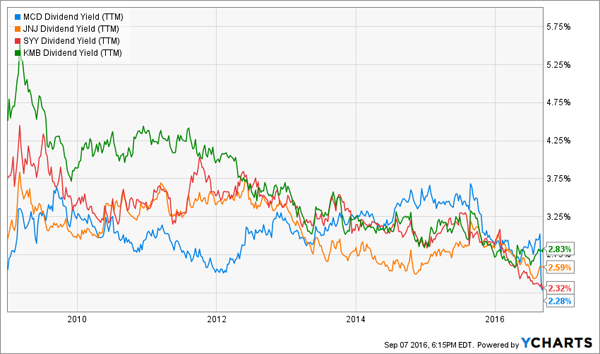Not yet familiar with preferred shares? With “common” shares paying so little, it’s time to get acquainted.
You can double your yields, and actually reduce your risk, by trading in your common shares for preferreds.
[ad#Google Adsense 336×280-IA]I’ll explain how – and will also warn you about an overlooked pitfall you should avoid.
Most investors only consider “common” shares of stock when they look for income. These are the shares in a company you receive when you place an order with your broker.
Problem is, most dividend darlings don’t pay much on their common shares today. You’ll be hard pressed to find a dividend aristocrat with a yield above 3% or a P/E ratio below 20 – evaporating business models or not!
A Bear Market in Common Yields

A company will issue preferred shares to raise capital. In return it will pay regular dividends on these shares – and as their name suggests, preferreds do receive their payouts before common shares. They typically get paid more, and even have a priority claim on the company’s earnings and assets in case something bad happens, like bankruptcy.
So far so good. The tradeoff? Less upside. But in today’s expensive stock market, it may not be a bad trade to make. Let’s walk through a couple transactions that would roughly double your current dividends with a simple trade-in.
Wells Fargo’s (WFC) common shares pay a respectable 3% today. But it recently issued shares of preferred stock paying 5.5% – almost double. If you’re looking for income, and you like Wells Fargo too, then the preferreds are a compelling play.
A million bucks in WFC common shares will only net you $30,000 today annually. That’s not even $15 an hour – there are coffee baristas down the block who make more! But the preferred option will land you a more respectable $55,000 per year passive gig.
Similarly common shares of JPMorgan (JPM) – which I like and own warrants on – pay 2.9%. Not bad, but you could more than double your yield by buying JPM’s “Series Y” preferred stock offering for 6.1% annually.
Series what? That’s a big problem with preferred shares – they are often complicated to purchase without the help of a human broker.
Which tempts many investors to streamline their online buys and simply purchase ETFs like the PowerShares Preferred Portfolio (PGX) and the iShares S&P U.S. Preferred Stock Index Fund (PFF). After all these funds pay 5.6% each and, in theory, they diversify your credit risk.
Be careful – because they actually expose you to unnecessary credit risk. The only way you lose with this vehicle is by giving your money to a driver who crashes your car. But the S&P 500 and NASDAQ are large enough that there’s usually a company financially crashing into a brick wall at any moment in time.
And if we include the brick wall the financial world ran into ten years ago, these funds haven’t even performed to their current yields:
The Problem With Financial Brick Walls

I suspect PGX and PFF probably won’t actually return 5.6% annually over the next decade, either. Which why I recommend moving past a broad-based ETF in favor of a fund with an active manager working for you. There’s extra yield to be had in preferred shares – but you should make sure you have an expert buying your stock to keep you safe and on the road.
My two favorite funds today pay 7.6% and 7.7% respectively. They’re excellent bargains because they are closed-end funds selling at discounts to their net asset values (NAVs).
Earlier this year, investors irrationally sold any and all closed-ends down to silly bargain prices. Some deservedly so, but these two high quality preferred funds – with excellent management teams and track records – were swept away by the hysteria.
That’s great for us. Low prices mean higher yields plus some upside as these funds gradually close their discount windows. And these 7.6% and 7.7% yields net us 27% more income, and do so more securely, than their ETF counterparts. Plus, these funds have a history of actually delivering these types of returns over the long haul (unlike the more popular ETFs).
— Brett Owens
Sponsored Link: A deeper understanding of both the stock and bond markets and the funds that provide these high incomes is necessary to building a strong, high-yield portfolio without with high risks. Billionaire investors are doing this right now—but you don’t have to be a billionaire yourself to follow in their footsteps.
“Bond God” Jeffrey Gundlach has been pounding the table over a particular group of funds that currently trade at significant discounts to net asset values and pay 8% yields—or more—simply because most people don’t know they exist. Click here to find out why Gundlach is so bullish on these funds and discover [more information on] my top three plays.
Source: Contrarian Outlook
